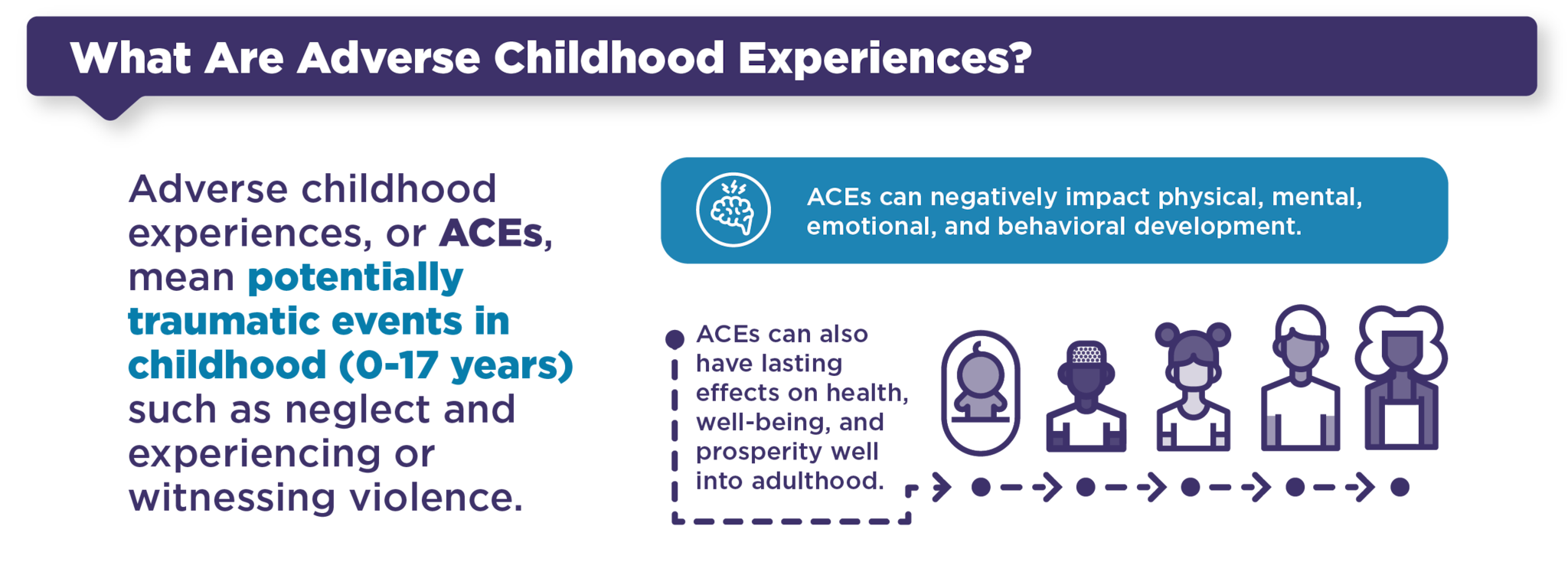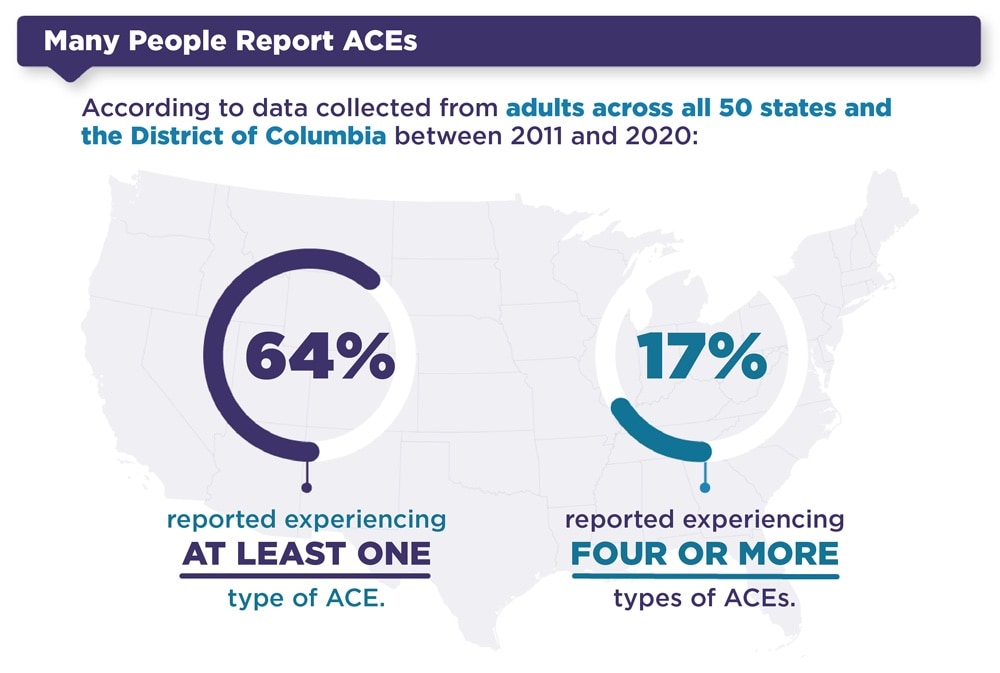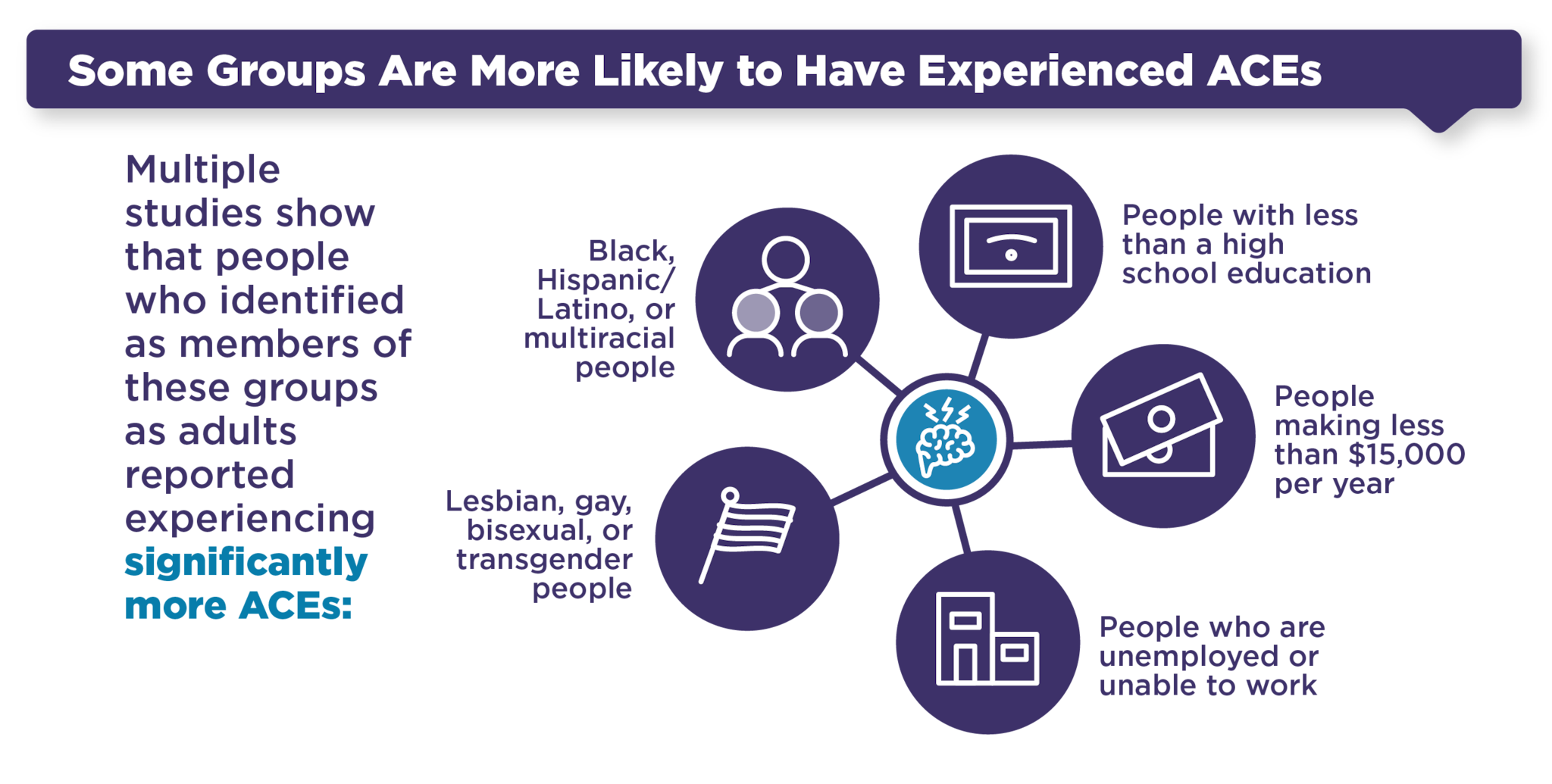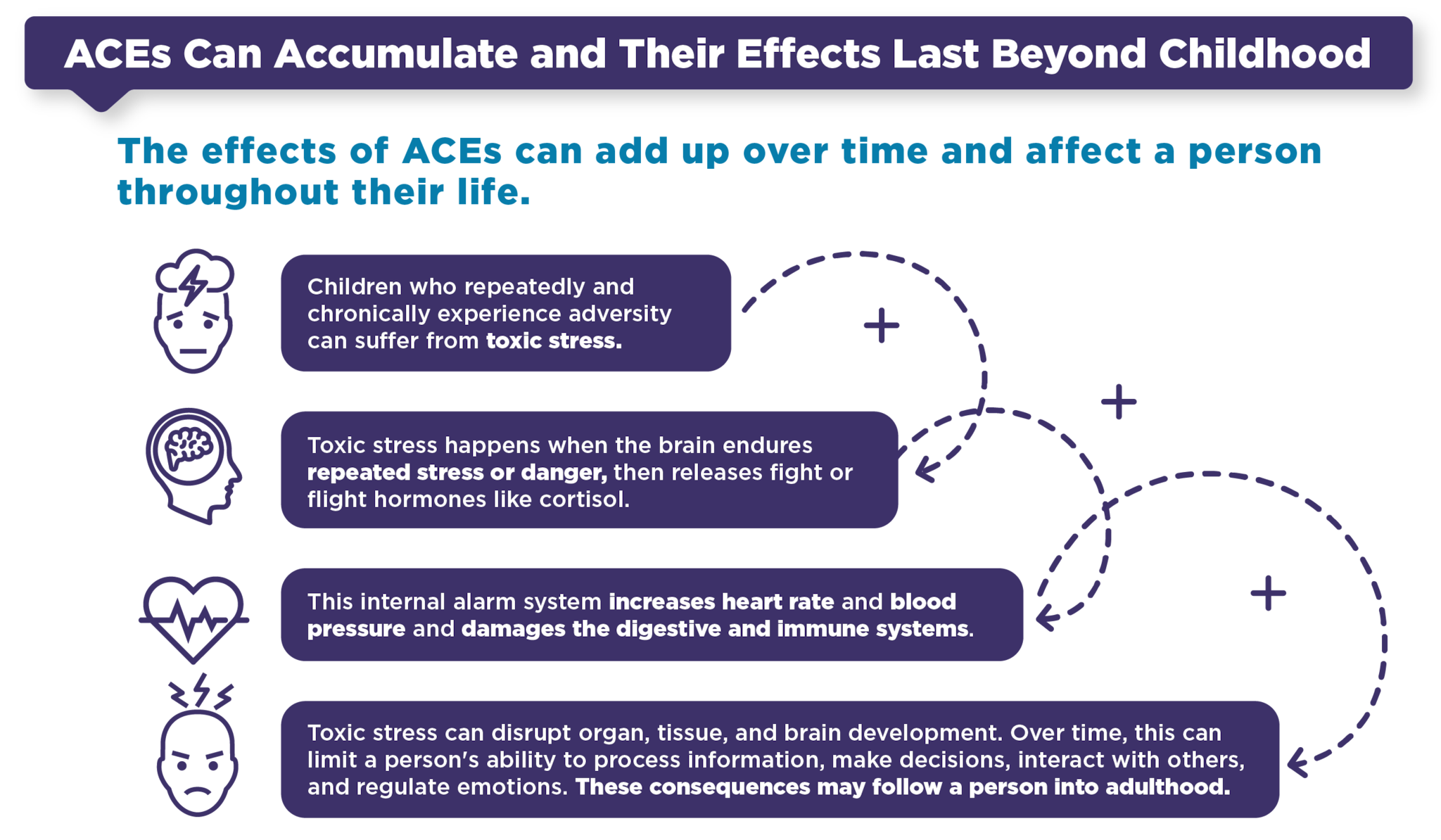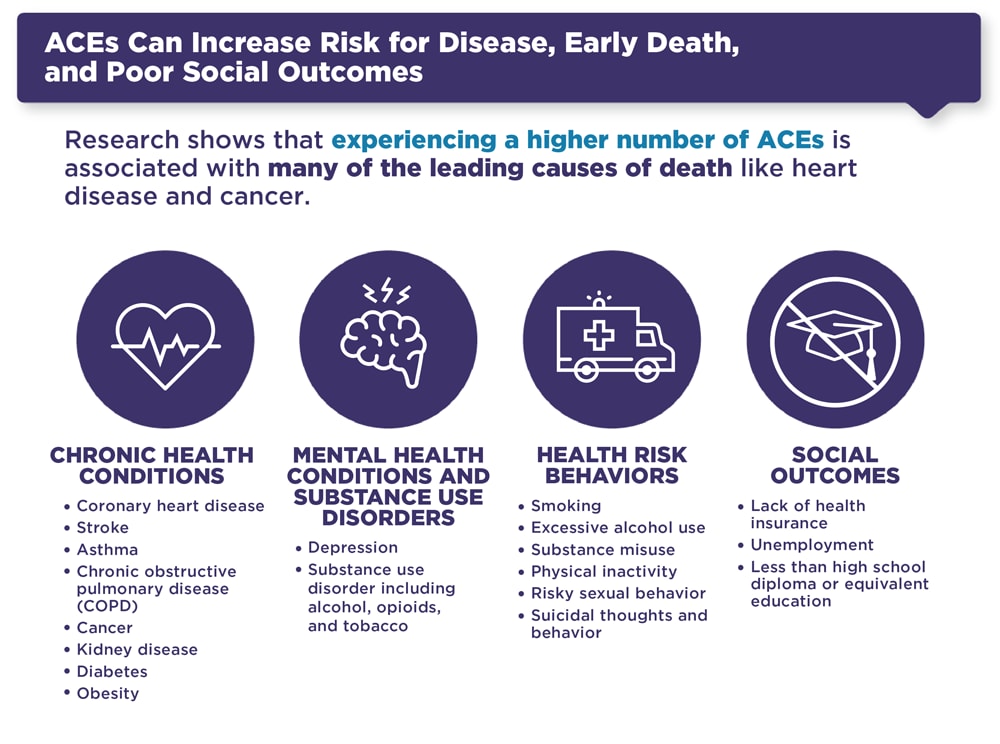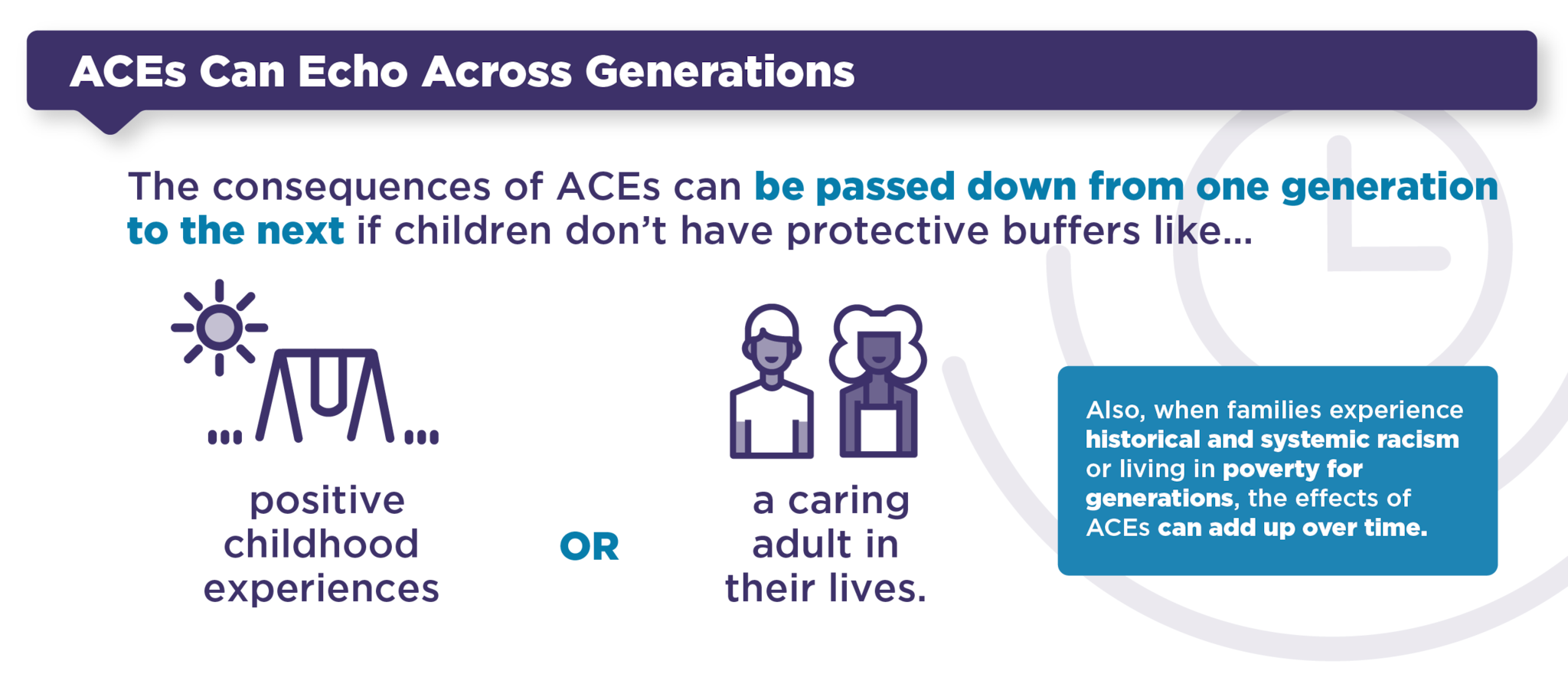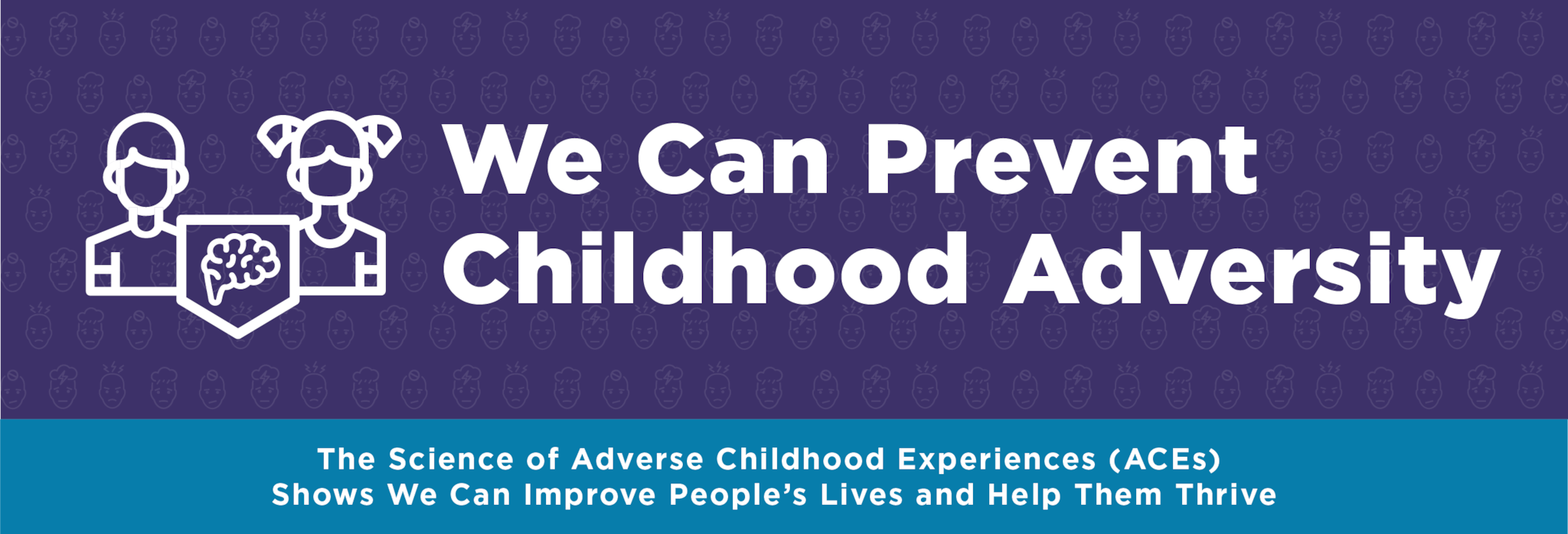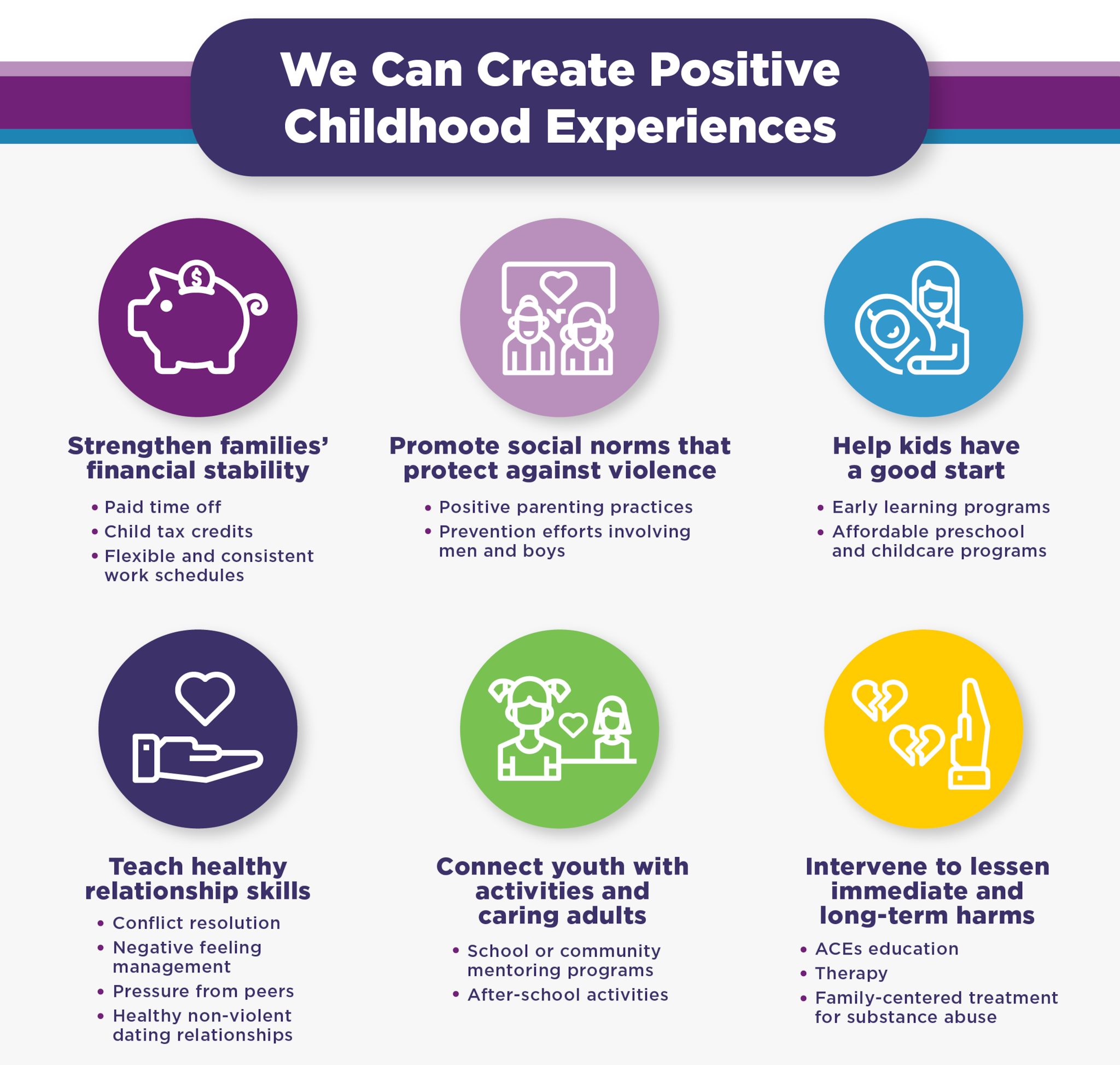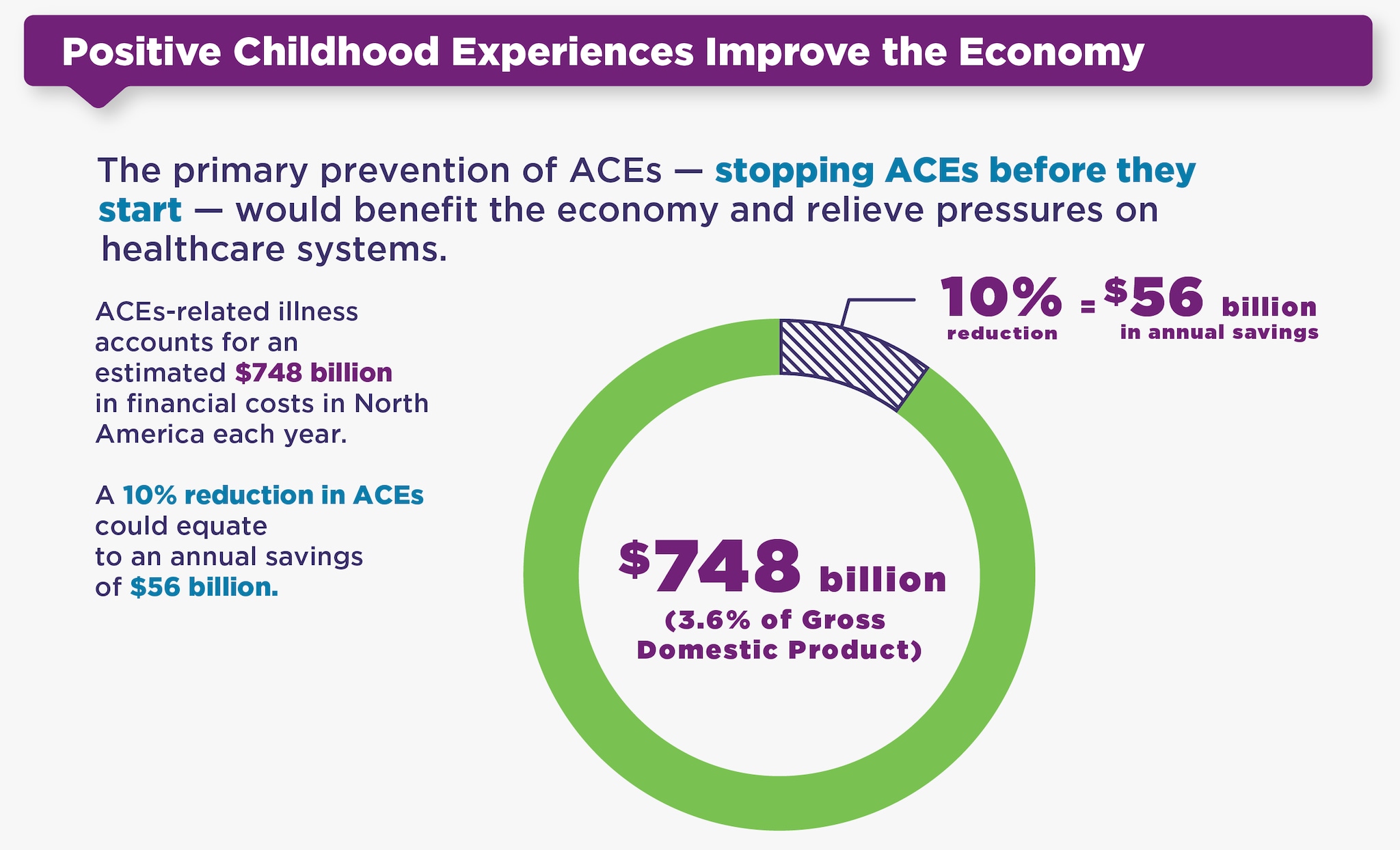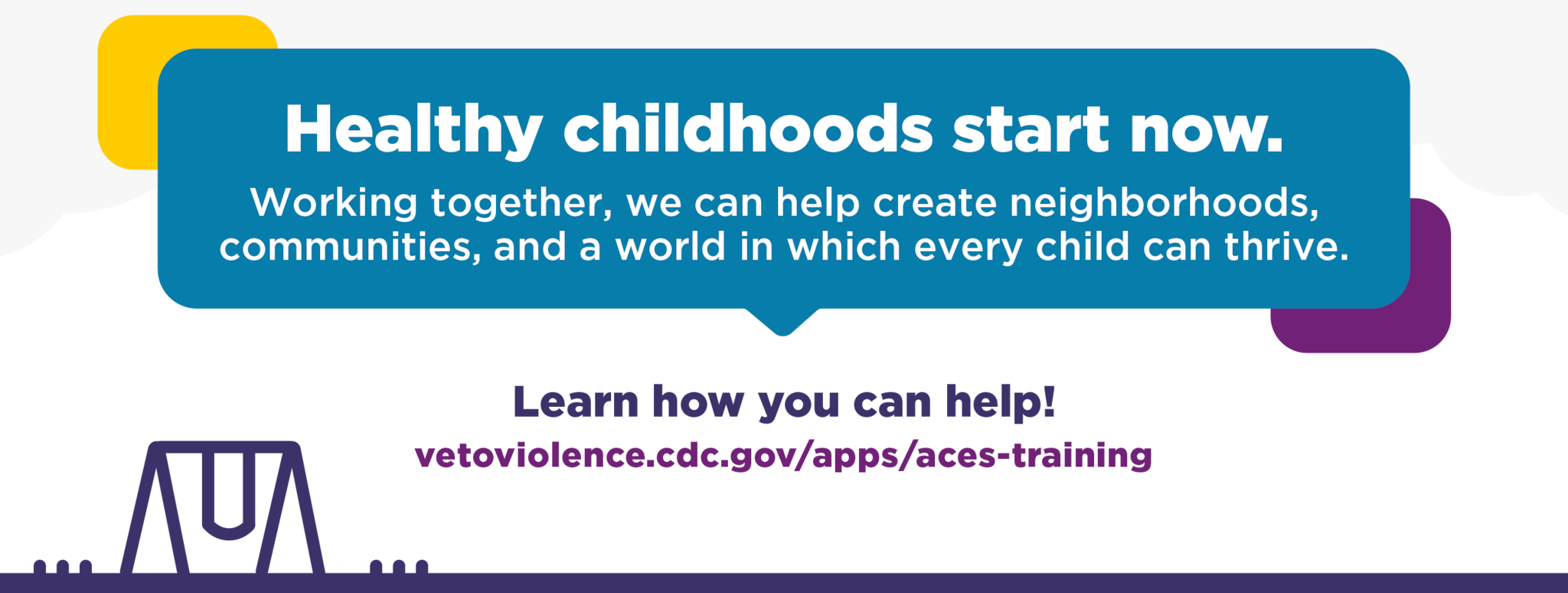Publications
Adverse Childhood Experiences (ACEs) Prevention Strategy Plan: This resource outlines CDC’s specific goals and objectives for ACEs prevention and response.
Adverse Childhood Experiences Prevention Resource for Action: This is a resource to help states and communities leverage the best available evidence to prevent ACEs from happening in the first place as well as lessen harms when ACEs do occur. It features six strategies drawn from the CDC Resources for Action, formerly known as, “technical packages.”
Child Abuse and Neglect Prevention Resource for Action: CDC’s Resource for Action, formerly known as, “technical package,” identifies a number of strategies based on the best available evidence to help states and communities prevent and reduce child abuse and neglect. Also available in Spanish.
Guidance for Analyzing 2021 Adverse Childhood Experiences and Positive Childhood Experiences Data: This resource provides guidance to help state and local agencies analyze Adverse Childhood Experiences (ACEs) and Positive Childhood Experiences (PCEs) data gathered on the 2021 Youth Risk Behavior Survey (YRBS).
Earned Income Tax Credits and Adverse Childhood Experiences: This fact sheet describes earned income tax credits and how they can help prevent adverse childhood experiences.
Swedo EA, Pampati S, Anderson KN, et al. Adverse Childhood Experiences and Health Conditions and Risk Behaviors Among High School Students — Youth Risk Behavior Survey, United States, 2023. MMWR Suppl 2024;73(Suppl-4):39–49. DOI: http://dx.doi.org/10.15585/mmwr.su7304a5.
Swedo EA, Aslam MV, Dahlberg LL, et al. Prevalence of Adverse Childhood Experiences Among U.S. Adults — Behavioral Risk Factor Surveillance System, 2011–2020. MMWR Morb Mortal Wkly Rep 2023;72:707–715. DOI: http://dx.doi.org/10.15585/mmwr.mm7226a2.
Anderson KN, Swedo EA, Trinh E, et al. Adverse childhood experiences during the COVID-19 pandemic and associations with poor mental health and suicidal behaviors among high school students – -Adolescent Behaviors and Experiences Survey, United States, January – June 2021. MMWR Morb Mortal Wkly Rep 2022;71:1301-1305. DOI: 10.15585/mmwr/mm7141a2.
Merrick MT, Ford DC, Ports KA, et al. Vital Signs: Estimated Proportion of Adult Health Problems Attributable to Adverse Childhood Experiences and Implications for Prevention — 25 States, 2015–2017. MMWR Morb Mortal Wkly Rep 2019;68:999-1005. DOI: http://dx.doi.org/10.15585/mmwr.mm6844e1.
Please note this is not an exhaustive list of journal articles examining adverse childhood experiences (ACEs). For a list of other articles examining the link between ACEs and specific health and life opportunity outcomes, please email dvpinquiries@cdc.gov.
Data sources
Behavioral Risk Factor Surveillance System (BRFSS): The BRFSS is an annual, state-based, random-digit-dial telephone survey that collects self-reported data from non-institutionalized U.S. adults regarding health conditions and risk factors.
Multiple Cause of Death or Mortality File: This is a portal to the online data dissemination activities of the Division of Vital Statistics, including both interactive online data access tools and downloadable public use data files. Data related to child abuse deaths can be queried using these tools.
National Health Interview Survey Injury Section (NHIS): The NHIS has monitored the health of the nation since 1957. NHIS data on a broad range of health topics are collected through personal household interviews. Recent survey years include data on adverse experiences like neighborhood violence, parental incarceration, household mental illness or substance use, food insecurity, and poverty.
National Hospital Ambulatory Medical Care Survey (NHAMCS): NHAMCS collects data on the use and provision of ambulatory care services in hospital emergency and outpatient departments and ambulatory surgery locations. Some years include the International Classification of Diseases (ICD) reason for visit code, which can be used to look at child abuse and neglect.
National Hospital Discharge Survey (NHDS): NHDS was a national probability survey designed to meet the need for information on characteristics of inpatients discharged from non-Federal short-stay hospitals in the United States. The dataset contains information on injury-related hospital stays; first and second diagnosis (ICD- 9CM including e-codes) codes can be used to look at child abuse and neglect.
National Violent Death Reporting System (NVDRS): NVDRS links information about the “who, when, where, and how” from data on violent deaths and provides insights about “why” they occurred. Includes information on such variables as victim-perpetrator relationship, suspect information when available, mechanism, and toxicology. Some states have added a child abuse and neglect module.
Pregnancy Risk Assessment Monitoring System (PRAMS): PRAMS collects state-specific, population-based data on maternal attitudes and experiences before, during, and shortly after pregnancy. Some states have added ACEs items.
Violence Against Children Survey (VACS): VACS is a nationally representative survey of children 13-24, that measures physical, emotional, and sexual violence against girls and boys.
Youth Risk Behavior Surveillance System (YRBSS): YRBSS monitors health risk behaviors that contribute to the leading causes of death, disability, and social problems among 9th through 12th grade students in the United States. State and national datasets include self-reported data on past 12-month incidence of interpersonal violence victimization, dating violence, and sexual assault. Some local and state health departments have included ACEs questions. This is emerging as one of the best, most reliable sources of ACEs data.
The Adoption and Foster Care Analysis and Reporting System (AFCARS): AFCARS collects case-level information from state and tribal title IV-E agencies on all children in foster care and those who have been adopted with title IV-E agency involvement.
Health Care Costs and Utilization Project (HCUP) National Inpatient Sample (NIS): HCUP includes the largest collection of longitudinal hospital care data in the United States. ICD codes can be used to examine abusive head trauma, child abuse, and neglect.
Longitudinal Studies of Child Abuse and Neglect (LONGSCAN): The goal of LONGSCAN is to follow the 1300+ children and their families until the children themselves become young adults. Yearly telephone interviews allow the sites to track families and assess yearly service utilization and important life events.
National Child Abuse and Neglect Data System (NCANDS): NCANDS is a federally sponsored effort that annually collects and analyzes data on child abuse and neglect known to child protective services (CPS) agencies in the United States.
National Crime Victimization Survey (NCVS): NCVS is the primary source of information on criminal victimization in the U.S. NCVS collects information from victims aged 12 years and older about incidents of nonfatal personal crimes, including physical and sexual abuse, both reported and not reported to police.
National Electronic Injury Surveillance System (NEISS): NEISS collects data on all injuries and any illnesses if the incident is related to a consumer product, medical device, or recreational or work activity. It includes information on the intent and external cause of the injury, which can be used to look at child abuse and neglect.
National Epidemiological Survey on Alcohol and Related Conditions Wave 3 (NESARC-III): The NESARC-III is cross-sectional, based on a nationally representative sample of the civilian noninstitutionalized population of the United States aged 18 years and older. The survey contains 29 questions pertaining to 10 ACE categories (child abuse, neglect, and household challenges).
National Incidence Study (NIS): The NIS studies are designed to estimate the incidence of child maltreatment in the United States more broadly by including both cases that are reported to the authorities as well as those that are not. NIS datasets contain measures related to abuse and neglect.
National Longitudinal Survey of Youth (NLSY 79): The NLSY79 is a nationally representative sample of 12,686 young men and women who were 14-22 years old when they were first surveyed in 1979. These individuals were interviewed annually through 1994 and are currently interviewed on a biennial basis. In 2012, ACE-related questions were asked, including childhood physical abuse, household alcohol abuse, household mental illness, and emotional neglect.
National Longitudinal Survey of Young Adults: In 1986, a separate survey of all children born to NLSY79 female respondents began. In addition to all the mother’s information from the NLSY79, the child survey includes assessments of each child as well as additional demographic and development information collected from either the mother or child. In 2012 and 2014, respondents were asked ACE-related questions, including items assessing mental illness and substance abuse in household, physical abuse, emotional neglect, and family conflict.
National Survey of Child and Adolescent Well-Being (NSCAW 1, 2, 3): NSCAW is a nationally representative, longitudinal survey of children and families who have been the subjects of investigation by Child Protective Services. NSCAW examines child and family well-being outcomes in detail and seeks to relate those outcomes to experience with the child welfare system and to family characteristics, community environment, and other factors. ACE-related items include neglect, abuse, and household challenges, as reported by parents, caregivers or caseworkers.
National Survey of Children’s Health (NSCH): NSCH provides data on multiple, intersecting aspects of children’s lives including physical and mental health, access to quality health care, and the child’s family, neighborhood, school, and social context. NSCH is funded and directed by the Health Resources and Services Administration (HRSA) Maternal and Child Health Bureau (MCHB). NSCH measures household challenges, such as socioeconomic hardship, parental separation or divorce, substance abuse in the household, witnessing neighborhood violence, witnessing domestic violence, incarcerated parent, racial or ethnic discrimination, and death of a parent.
Adolescent Brain Cognitive Development Study (ABCD): The ABCD Study is the largest long-term study of brain development and child health in the United States. ACEs assessed include physical abuse, sexual abuse, household violence, household substance abuse, mental illness in household, incarcerated household member, emotional neglect, and physical neglect.
Monitoring the Future Study (MTF): MTF is an ongoing study of the behaviors, attitudes, and values of Americans from adolescence through adulthood. Adverse experiences measured by MTF include physical violence victimization.
National Comorbidity Survey – adolescent supplement (NCS-A): NCS-A was designed to estimate the lifetime-to-date and current prevalence, age-of-onset distributions, course, and comorbidity of DSM-IV disorders in the child and adolescent years of life among adolescents in the United States; to identify risk and protective factors for the onset and persistence of these disorders; to describe patterns and correlates of service use for these disorders; and to lay the groundwork for subsequent follow-up studies that can be used to identify early expressions of adult mental disorders.
National Longitudinal Study of Adolescent Health (Add Health): Add Health is a longitudinal study of a nationally representative sample of adolescents in grades 7-12 in the United States during the 1994-95 school year. Wave IV variables include childhood/adolescent adversities, such as death of a parent or caregiver, parental incarceration, death of a sibling, sexual violence victimization, child abuse, and neglect.
National Survey of Children’s Exposure to Violence (NatSCEV): NatSCEV, funded by the Office of Juvenile Justice and Delinquency Prevention and the CDC, is designed to document the incidence and prevalence of children’s exposure to violence, with special emphasis on exposure to domestic and community violence.
Project on Human Development in Chicago Neighborhoods (PHDCN): PHDCN is an interdisciplinary study of how families, schools, and neighborhoods affect child and adolescent development. In particular, the Project examined the pathways to juvenile delinquency, adult crime, substance abuse, and violence. ACE items measured included household mental illness, parental incarceration, witnessed violence, and parental report of children’s exposure to physical and sexual violence.
Rochester Youth Development Study (RYDS): RYDS was initiated in 1986 to study the causes and consequences of delinquency and drug use in an urban sample of adolescents. ACE measures included neglect and physical and sexual abuse.
Rochester Intergenerational Study (RIGS): The intergenerational component of the RYDS examines the development of antisocial behavior in a three-generation prospective panel study, by making the children of the original subjects of the RYDS the focal subjects of a long-term study. Adverse experience items included family conflict, harsh parenting, and financial strain.
General resources
Child Development: CDC’s Web page on child development includes information on developmental milestones, screening, and positive parenting.
Essentials for Parenting Teens: CDC web resource designed for parents and caregivers of 11 to 17-year-olds. Learn approaches to parenting teens and access articles, videos, and activities.
Essentials for Parenting Toddlers and Preschoolers: CDC’s web resource on strategies parents can use to help build a safe, stable, and nurturing relationship with their two to four-year-old child. Includes information on common parenting challenges and solutions.
Parent’s Portal: A wealth of information from across all of CDC, covering everything from safety at home and the community to immunization schedules and developmental milestones.
Policy Approaches to Preventing Adverse Childhood Experiences: CDC’s web page that highlights policy approaches for preventing adverse childhood experiences.
Preventing Adverse Childhood Experiences Trainings: These online trainings are designed to help users understand, recognize, and prevent ACEs from occurring in the first place. There is an introductory Training Module as well as modules with information for professionals working directly with and on behalf of kids and families.
Adverse Childhood Experiences Infographic: This infographic uses data from the CDC-Kaiser Permanente Adverse Childhood Experiences (ACEs) Study and recent findings to show how ACEs and prevention can affect people’s lives and society.
Connecting the Dots: A free, online training that helps users explore shared risk and protective factors across multiple forms of violence.
Making the Case: Engaging Businesses: A free online resource that explains how communities can work with the business sector to assure safe, stable, nurturing relationships, and environments for all children and families.
Principles of Prevention: Online training on how to apply key concepts of primary prevention, the public health approach, and the social-ecological model for violence prevention work.
Administration for Children and Families’ Children’s Bureau’s Prevention Page: This page provides resources to support child abuse and neglect programs, researchers, and monitoring systems.
National Offices of Violence Prevention Network: The National Offices of Violence Prevention Network is a coalition of local governments committed to reimagining public safety. The newly formed Network brings together the leaders of civilian local government offices dedicated to community-driven safety solutions, known as offices of violence prevention (OVPs).
National Maternal Mental Health Hotline: The National Maternal Mental Health Hotline provides free, confidential, 24/7 emotional support, resources, and referrals to pregnant and postpartum individuals facing mental health challenges and their loved ones. Counselors offer support by phone and text in English and Spanish. Interpreter services are available in 60 additional languages. For help when it’s needed, call or text 1-833-943-5746 (1-833-9-HELP4M(oms)). TTY users can use a preferred relay service or dial 711 and then 1-833-943-5746.
National Indian Health Board ACEs Hub: This information hub includes a “resource basket” designed for American Indian and Alaska Native individuals, families, communities, professionals, and leaders that can assist Tribes to learn more about ACEs, research, tools, and interventions.

